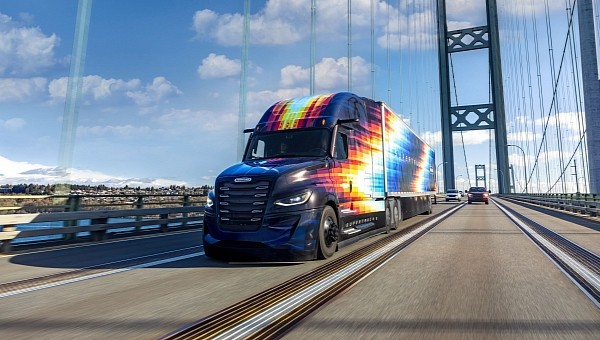If you're from North America, you might be familiar with Freightliner trucks, a subsidiary of Daimler Truck North America (DTNA). This week, the brand revealed the Freightliner SuperTruck II in Las Vegas, and I'd like to tell you more about how it uses a range of technical innovations to improve efficiency.
The SuperTruck II is currently a concept vehicle developed as part of the company's SuperTruck program – the aim is to reduce emissions in road freight transport. Given that these emissions impact the environment, the United States Department of Energy also helped fund the initiative. Furthermore, DTNA engineers are researching next-gen heavy-duty commercial truck technologies and how to integrate them into series production.
DTNA has identified several key areas where technology can be innovated to improve efficiency: tractor aerodynamics, powertrain, energy management, and low-rolling resistance tires. The company focuses on developing core components and systems that could potentially be implemented for customers.
DTNA introduced the first version of the SuperTruck in 2015, which turned out to be a success. Now, the company has surpassed expectations in all the key areas and has doubled the freight efficiency of the truck compared to its predecessor.
Regarding aerodynamics, engineers managed to reduce the overall aerodynamic drag of the SuperTruck II by more than 12% over the first variant. They didn't change the truck's structure; instead, they used the existing shape of the Cascadia model and modified its design to maximize aerodynamic efficiency.
Let's see how engineers played with the design – first, the hood, bumper, and chassis fairing are a perfect fit for the existing cab structure, and they're engineered to enable undisturbed airflow around the truck. Furthermore, the door, grille, and air intakes were transformed to be as seamless as possible to minimize air turbulence.
Finally, the Active Aero elements provide crucial aerodynamic improvements. The active side extenders and a roof spoiler system close the trailer gap by up to four inches when the vehicle reaches highway speeds. An enhanced Aerodynamic Height Control system lowers the truck inches off the pavement. A mirrorless camera system completes the aerodynamic upgrades to avoid drag from exterior mirrors.
The powertrain plays a significant role in the overall efficiency of the truck – the SuperTruck II boasts the most efficient powertrain a Freightliner truck has ever seen. It allows for a 5.7 percent fuel consumption reduction over SuperTruck I by decreasing drag overdrive, and a 48 V electrical system uses lithium-ion batteries to lower fuel consumption. Moreover, a new electric A/C helps keep the driver cool and can continue running even when the engine is turned off.
Lastly, other critical elements for increasing efficiency are the tires – by using fresh, specifically engineered tires, energy consumption can be cut down, and maintenance downtime can be diminished by minimizing wear and tear.
DTNA has identified several key areas where technology can be innovated to improve efficiency: tractor aerodynamics, powertrain, energy management, and low-rolling resistance tires. The company focuses on developing core components and systems that could potentially be implemented for customers.
DTNA introduced the first version of the SuperTruck in 2015, which turned out to be a success. Now, the company has surpassed expectations in all the key areas and has doubled the freight efficiency of the truck compared to its predecessor.
Regarding aerodynamics, engineers managed to reduce the overall aerodynamic drag of the SuperTruck II by more than 12% over the first variant. They didn't change the truck's structure; instead, they used the existing shape of the Cascadia model and modified its design to maximize aerodynamic efficiency.
Let's see how engineers played with the design – first, the hood, bumper, and chassis fairing are a perfect fit for the existing cab structure, and they're engineered to enable undisturbed airflow around the truck. Furthermore, the door, grille, and air intakes were transformed to be as seamless as possible to minimize air turbulence.
Finally, the Active Aero elements provide crucial aerodynamic improvements. The active side extenders and a roof spoiler system close the trailer gap by up to four inches when the vehicle reaches highway speeds. An enhanced Aerodynamic Height Control system lowers the truck inches off the pavement. A mirrorless camera system completes the aerodynamic upgrades to avoid drag from exterior mirrors.
The powertrain plays a significant role in the overall efficiency of the truck – the SuperTruck II boasts the most efficient powertrain a Freightliner truck has ever seen. It allows for a 5.7 percent fuel consumption reduction over SuperTruck I by decreasing drag overdrive, and a 48 V electrical system uses lithium-ion batteries to lower fuel consumption. Moreover, a new electric A/C helps keep the driver cool and can continue running even when the engine is turned off.
Lastly, other critical elements for increasing efficiency are the tires – by using fresh, specifically engineered tires, energy consumption can be cut down, and maintenance downtime can be diminished by minimizing wear and tear.







